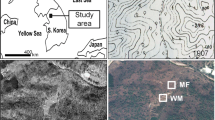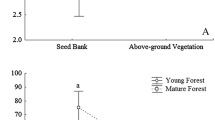Abstract
Soil seed banks of anthropogenic native grassland and grassy forest remnants on the Gippsland Plain in south-eastern Australia were studied using the seedling emergence method. Intact examples of both ecosystems are rare, owing to extensive agricultural development. Both ecosystems are assumed to have been derived since European settlement from the same original, grassy forest ecosystem. It was hypothesised that species now restricted to grassland remnants might persist in the soil seed bank of forest remnants, and vice versa. This hypothesis was not supported. In total, 25554 seedlings of at least 155 species emerged from forest and grassland seed banks collectively. Small-seeded, annual and perennial herbs were most abundant. Forest seedbanks differed substantially in composition from grassland seedbanks, and both essentially contained a subset of the species in the vegetation. Forest seedbanks contained significantly more species and individuals of annual and perennial native dicotyledons than grassland seedbanks. Seedbanks made a major contribution to local diversity, since many species in the seed bank at each quadrat were not recorded from the vegetation, but only a minor contribution to regional diversity. Species in the seedbank that were absent from all vegetation samples were recorded at few quadrats, except Juncus species, which were widespread and abundant in the seedbank. The apparent absence from forest seed banks of species that are best represented in grassland remnants (and vice versa), suggests that there is little opportunity of recruiting grassland-restricted species in forest remnants by instigating grassland management practices.
Similar content being viewed by others
References
Andersen, A. N. & Ashton, D. H. 1985. Rates of seed removal by ants at heath and woodland sites in southeastern Australia. Austr. J. Ecol. 10: 381-390.
Auld, T.D. & O’Connell, M. A. 1991. Predicting patterns of post-fire germination in 35 eastern Australian Fabaceae. Austr. J. Ecol. 16: 53-70.
Belbin, L. 1994. Technical reference PATN pattern analysis package. CSIRO Division of Wildlife and Ecology, Canberra.
Bellairs, S. M. & Bell, D. T. 1990. Canopy-borne seed store in three Western Australian plant communities. Austr. J. Ecol. 15: 299-305.
Carroll, E. J. & Ashton, D. H. 1965. Seed storage in soils of several Victorian plant communities. Victorian Naturalist 82: 102-110.
Cunningham, G. M., Mulham, W. E., Milthorpe, P. L. & Leigh, J. H. 1981. Plants of western New South Wales. Soil Conservation Service of New South Wales, Sydney.
DeKock, B. & Taube, M. 1991. Reproductive phenology of seven native forbs and implications for their establishment and management. Unpubl. B. App. Sc. Horticulture thesis, Victorian College of Agriculture and Horticulture-Burnley Campus, Melbourne.
Enright, N. J. & Lamont, B. B. 1989. Seed banks, fire season, safe sites and seedling recruitment in five co-occurring Banksiaspecies. J. Ecol. 77: 1111-1116.
Gilfedder, L. & Kirkpatrick, J. B. 1993. Germinable soil seed and competitive relationships between a rare native species and exotics in a semi-natural pasture in the Midlands, Tasmania. Biol. Cons. 64: 113-119.
Grubb, P. J. 1977. The maintenance of species-richness in plant communities: the importance of the regeneration niche. Biol. Rev. 52: 107-145.
Hitchmough, J., Berkeley, S. & Cross, R. 1989. Flowering grasslands in the Australian landscape. Landscape Australia 4: 394-403.
Lamont, B. B., LeMaitre, D. C., Cowling, R. M. & Enright, N. J. 1991. Canopy seed storage in woody plants. Bot. Rev. 57: 277- 317.
Leck, M. A. 1989. Wetland seed banks. Pp. 283-305. In: Leck, M. A., Parker, V. T. & Simpson, R. L. (eds), Ecology of soil seed banks. Academic Press, San Diego.
Leck, M. A., Parker V. T. & Simpson, R. L. (eds) 1989. Ecology of soil seed banks. Academic Press, San Diego.
Leigh, J. H., Wood, D. H., Slee, A. V. & Holgate, M. D. 1991. The effects of burning and simulated grazing on productivity, forage quality, mortality and flowering of eight subalpine herbs in Kosciusko National Park. Austr. J. Bot. 39: 97-118.
Lunt, I. D. 1990. The soil seed bank of a long-grazed Themeda triandragrassland in Victoria. Proc. Roy. Soc. Victoria 102: 53-57.
Lunt, I. D. 1994a. The extinct grasslands of the lowland Gippsland plains. pp. 9-12. In: McDougall, K. & Kirkpatrick, J. B. (eds), Conservation of lowland native grasslands in south-eastern Australia. World Wide Fund for Nature, Australia.
Lunt, I. D. 1994b. Variation in flower production of nine grassland species with time since fire, and implications for grassland management and restoration. Pacific Cons. Biol. 1: 359-366.
Lunt, I. D. 1995a. European management of remnant grassy forests and woodlands in south-eastern Australia-past, present and future? Victorian Naturalist 112: 239-249.
Lunt, I. D. 1995b. Seed longevity of six native forbs in a closed Themeda triandragrassland. Austr. J. Bot. 43: 439-449.
Lunt, I. D. 1996. A transient soil seed bank for the Yam-daisy Microseris scapigera. Victorian Naturalist 113: 16-19.
Lunt, I. D. in press. Effects of long-term vegetation management on remnant grassy forests and anthropogenic native grasslands in south-eastern Australia. Biol. Cons.
Major, J. & Pyott, W. T. 1966. Buried viable seeds in two California bunch grass sites and their bearing on the definition of a flora. Vegetatio 13: 253-282.
McDougall, K. & Kirkpatrick, J. B. (eds) 1994. Conservation of lowland native grasslands in south-eastern Australia. World Wide Fund for Nature, Sydney.
McIntyre, S. 1990. Germination in eight native species of herbaceous dicot and implications for their use in revegetation. Victorian Naturalist 107: 154-158.
Morgan, J.W. 1995a. Ecological studies of the endangered Rutidosis leptorrhynchoides. I. Seed production, soil seed bank dynamics, population density and their effects on recruitment. Austr. J. Bot. 43: 1-11.
Morgan, J.W. 1995b. Ecological studies of the endangered Rutidosis leptorrhynchoides. II. Patterns of seedling emergence and survival in a native grassland. Austr. J. Bot. 43: 13-24.
Morgan, J. W. & Lunt, I. D. 1994. Germination characteristics of eight common grassland and woodland forbs. Victorian Naturalist 111: 10-17.
Prober, S. M. & Thiele, K. R. 1995. Conservation of the grassy white box woodlands: relative contributions of size and disturbance to floristic composition and diversity of remnants. Austr. J. Bot. 43: 349-366.
Pyrke, A. 1993. The role of soil disturbance by small mammals in the establishment of rare plant species. Unpublished report to the Australian National Parks and Wildlife Service, Canberra.
Rabinowitz, D. 1981. Buried viable seeds in a North American tall-grass prairie: the resemblance of their abundance and composition to dispersing seeds. Oikos 36: 191-195.
Reader, R. J. 1993. Control of seedling emergence by ground cover and seed predation in relation to seed size for some old-field species. J. Ecol. 81: 169-175.
Roberts, H. A. 1981. Seed banks in soils. Adv. Appl. Biol. 6: 1-55.
Ross, J. H. 1993. A census of the vascular plants of Victoria. 4th. ed. Royal Botanic Gardens, Melbourne.
Sokal, R. R. & Rohlf, F. J. 1981. Biometry. W. H. Freeman and Co., New York.
Stuwe, J. & Parsons, R. F. 1977. Themeda australisgrasslands on the Basalt Plains, Victoria: floristics and management effects. Austr. J. Ecol. 2: 467-476.
Thompson, K. & Grime, J. P. 1979. Seasonal variation in the seed banks of herbaceous species in ten contrasting habitats. J. Ecol. 67: 893-921.
Tremont, R. M. 1994. Life-history attributes of plants in grazed and ungrazed grasslands on the Northern Tablelands of New South Wales. Austr. J. Bot. 42: 511-530.
van der Valk, A. G. 1981. Succession in wetlands: a Gleasonian approach. Ecology 62: 686-696.
van der Valk, A. G. & Davis, C. B. 1978. The role of seed banks in the vegetation dynamics of prairie glacial marshes. Ecology 59: 322-335.
Walsh, N. G. & Entwisle, T. J. 1994. Flora of Victoria Volume 2. Ferns and allied plants, conifers and monocotyledons. Inkata Press, Melbourne.
Watson, S. 1995. Seed ecology of five native forbs in a basalt plains grassland. Unpubl. thesis, Victorian College of Agriculture and Horticulture - Burnley Campus, Melbourne.
Williams, E.D. 1984. Changes during 3 years in the size and composition of the seed bank beneath a long-term pasture as influenced by defoliation and fertilizer regime. J. Appl. Ecol. 21: 603-615.
Willis, A. J. & Groves, R. H. 1991. Temperature and light effects on the germination of seven native forbs. Austr. J. Bot. 39: 219-228.
Wisheu, I. C. & Keddy, P.A. 1991. Seed banks of a rare wetland plant community: distribution patterns and effects of human-induced disturbance. J. Vegetation Sci. 2: 181-188.
Withers, J. R. 1976. The structure and regeneration of unburnt Eucalyptuswoodland at Ocean Grove, Victoria. Ph.D. thesis, Botany Dept, University of Melbourne, Melbourne.
Yates, C. J., Taplin, R., Hobbs, R. J. & Bell, R. W. 1995. Factors limiting the recruitment of Eucalyptus salmonophloiain remnant woodlands. II. Post-dispersal seed predation and soil seed reserves. Austr. J. Bot. 43: 145-155.
Author information
Authors and Affiliations
Rights and permissions
About this article
Cite this article
Lunt, I.D. Germinable soil seed banks of anthropogenic native grasslands and grassy forest remnants in temperate south-eastern Australia. Plant Ecology 130, 21–34 (1997). https://doi.org/10.1023/A:1009780301775
Issue Date:
DOI: https://doi.org/10.1023/A:1009780301775




